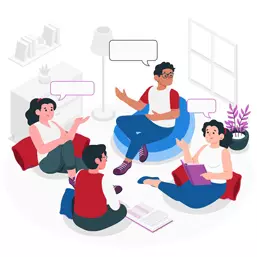
Effective Verbal Communication
Be sincere; be brief; be seated.
– Franklin D. Roosevelt
Introduction
Verbal communication is the exchange of information with other individuals via the use of words. As a result, it may refer to both oral and textual communication methods. Many people believe that the phrase refers primarily to oral communication. The verbal portion of communication is concerned with the words that you use and how they are received and perceived by the recipient.
There are several verbal communication skills. They vary from the apparent (such as the ability to talk properly or listen) to more subtle (such as reflecting and clarifying). It’s important to remember that good verbal communication cannot be completely isolated from non-verbal communication, which includes your body language, tone of voice, and facial expressions. Clarity of speech, maintaining a calm and concentrated state of mind, being courteous, and adhering to certain fundamental etiquette norms all contribute to the process of verbal communication.
The Fundamentals of Verbal Communication
Effective Speaking: Effective speaking is comprised of three components: the words you pick, the way you deliver them, and the way you reinforce them using non-verbal communication. All of these factors have an effect on how your message is sent and how it is received and comprehended by your audience.

It is good to analyze your word choice carefully. You’ll very certainly need to employ a variety of different terms in a variety of settings, even while describing the same topic. For instance, how you communicate with a close colleague will vary significantly from how you present a topic at a big conference. The way you communicate is determined by your tone of voice and tempo. As with non-verbal communication in general, they convey critical signals to your audience, such as your degree of attention and dedication or your level of nervousness about their reply.
Active listening: It is a critical ability. However, when we communicate, we spend significantly more time thinking about what we’re going to say than we do listening to the other person. Effective listening is critical for verbal communication to be successful. There are many techniques to improve your listening effectiveness. These include the following:
Be willing to listen. Concentrate on the speaker, not on your response.
Maintain an open mind and refrain from passing judgment on the speaker.
Concentrate on the speaker’s primary message. Attempt to comprehend both the broad strokes of what they’re saying and the specifics of the words they’re using.
Distractions should be avoided at all costs. For instance, if there is a lot of background noise, you can propose moving to a different location to speak.
Maintain objectivity. While the other person is providing facts, do not attempt to formulate your following question.
Refrain from focusing only on one or two things at the detriment of others. Make the most of the big picture and all of the facts available to you.
Avoid making stereotypical assumptions about the speaker. Prejudices based on gender, ethnic origin, accent, socioeconomic status, appearance, or attire should be avoided, which interfere with what is being stated.
Using the STAR acronym
Now let’s examine the actual message you’re conveying. Using the STAR acronym, you may verify that every communication is clear, comprehensive, accurate, and succinct. The STAR acronym will be discussed in connection with the six roots of open questions (Who? What? When? Where? Why? How? ).
S = Situation
S is an abbreviation for Situation. To begin, describe the current circumstance. Try to keep it to no more than one phrase in length. If you are experiencing difficulty, ask yourself the following questions: “Where?”, “Who?”, and “When?”. This will serve as a foundation for the message, allowing it to be clear and succinct. Look at the following example, “On Tuesday, I was at a director’s meeting at the main factory”.
T = Task
T is an abbreviation for Task. After that, briefly describe the nature of your assignment. Once again, this should be no more than one phrase in length. In order to structure your phrase, start with the question “What?” and finish with “Why?” if necessary. Look at the following example, “I was requested to give a presentation to the group on the sales data from the previous year”.
A = Action
Now, in a single phrase, describe what you did to remedy the situation. This section of the statement should be introduced with the question “How?” The Action section will offer a thorough overview of the problem and specify the specific activities that will be taken to remedy it. “I got up my laptop, launched PowerPoint, and delivered my slide presentation,” for example.
R = Result
Finally, describe the outcome of the experiment. This will often make use of a mix of the six root systems. Once again, a succinct and exact presentation of the outcomes of your previous stages will bring your essay to a close on a powerful and conclusive note. “Everyone was blown away by my preparation work, as well as our impressive numbers!”
Brief check
Strong verbal communication skills can help you be hired and succeed on the job.

Overview
Consider a comprehensive example with STAR. Consider the following scenario: you’re out with buddies on a weekend. Someone inquires as to the highlight of your workweek. As it happens, you had an excellent week, and there is plenty to discuss. You utilize STAR to concentrate your response in order to avoid boring your friends and to provide a clear message. “On Tuesday, I was at a director’s meeting at the main factory,” you answer. “I was requested to provide the group with last year’s sales numbers. I retrieved my laptop, launched PowerPoint, and began presenting my slide presentation. Everyone was taken aback by my preparation work and our magnificent figures!”
This structure may be condensed for brief exchanges or extended for longer presentations. We invite you to experiment with STAR-framed remarks and see how much more confident you feel when talking.
Factors that interfere with efficient verbal communication
Lack of clarity: Avoid confusing your audience with complex or too formal language, or with the use of colloquial language and jargons. These will blur your message more than they will help to impress your audience.
Making use of stereotypes and broad generalizations: In addition to reducing their own clarity and trustworthiness, speakers who make unqualified generalizations harm their own credibility.
Another kind of generalization is “polarization,” which is defined as the creation of extremes. Avoid seeing the world in black and white, and instead focus on understanding the complexity of different situations and people’s personalities.
Jumping to conclusions: Confusion between facts and conclusions is a typical occurrence. Don’t make the mistake of assuming you understand the causes for events or that particular facts must have certain meanings. Prepare by gathering all of the information you can, and then talk plainly about the facts as opposed to any meanings or interpretations you may have attached to them, if at all possible.
Responses that are not functioning: Ignoring or failing to react to a criticism or query within a reasonable amount of time inhibits good communication.
In the same way, answering with an irrelevant remark — one that isn’t related to the issue at hand — will suffocate true dialogue.
The act of interrupting someone else while they are speaking also creates a hostile atmosphere for effective communication.
Lacking in self-assurance: Lack of self-assurance may be a significant impediment to successful communication. Shyness, difficulties asserting oneself, and poor self-esteem may all impair your capacity to communicate your needs and thoughts effectively.
In addition, a lack of understanding of your own rights and possibilities in a certain scenario might hinder you from expressing your demands freely and honestly.
Brief check
Speaking in a moderately low-pitched voice at about 125 words a minute makes you sound pleasing and professional.
Techniques for delivering good oral communication
Concentrate on the problem rather than on the individual: Take nothing personally, and convey your own needs and ideas in the context of the task at hand without taking anything personally in return.
Instead of attempting to exert control over people, focus on solving issues: For example, if a student consistently answers questions in class with improper tangents, rather than just ignoring the student, talk with the student outside of class about how this may disrupt the class and distract other students.

Instead of being manipulative, be sincere: Be yourself, honestly and freely, and you’ll be OK. Be honest with yourself, and put your energy into building strong relationships with others around you while maintaining your integrity.
Instead of being distant, empathize with the other person: When it comes to engagement with coworkers, professional relationships require certain limits; yet, it is crucial to display compassion and genuine concern for the individuals with whom you work.
Working with people who do not care about you will be challenging if you don’t show them that you care about them when it comes to collaboration.
Be adaptable in your interactions with people: Allow for other points of view and be open to alternative methods of accomplishing tasks. Creativity and innovation are fostered by diversity.
Brief check
Like an actor, use your verbal communication as a tool to influence others.
Take pride in yourself and your own life experiences: Maintain your self-confidence and assertiveness on your own rights and wants. When you undervalue yourself, you encourage others to undervalue you as well. Offer your suggestions, and you can expect to be handled courteously.
Make use of affirmative replies: Respond to others in a manner that acknowledges their feelings and circumstances. Thank them for taking the time to provide feedback. Even if you disagree with their emotions, affirm their right to express them. Engage in open and honest dialogue with others, convey good feelings, and offer positive comments whenever possible.
Practical Application
The boss at a publishing company was worried about the falling advertising revenue of their newspaper. So he asked Keith and Gordon to design a new promotional package for the potential advertisers and do whatever they could to help out in that dire situation.
Keith and Gordon were discussing several ideas to design the new promotional package. The aim was to get the long-term advertisers to renew their contracts. The boss had asked them to complete the task within two days and they were feeling a great deal of pressure.
They had issues communicating their ideas, and really didn’t know where to start, until Keith suggested they use the STAR acronym to design the promotional package and get their respective messages across. Gordon agreed and together they worked on the Situation, Task, Action and Result of their messages to communicate their ideas in a better way. Here’s an example of how they applied the STAR method:
The Situation was that the Advertising revenue was falling off for the newspaper. A large number of long-term advertisers were not renewing their contracts.
The Task was to design a new promotional package in order to allure the advertisers to continue advertising.
Keith and Gordon took the Action by designing a new promotional package that would go with a rate sheet. For their main message they highlighted (1) their competitive rate (2) their newspaper circulation and viewership by comparing it with other ad media in the area.
Another Action they took was to set-up a special training session for the staff handling accounts with a sales expert who discussed competitive selling strategies.
As a Result of their effort, the company was able to sign contracts with 15 former advertisers for daily ads and five for special supplements. The company increased their new advertisers by 20 percent over the same period last year.
Keith and Gordon were happy when they’d completed their task successfully because the STAR acronym had allowed them to communicate several brilliant ideas. These would surely impress the boss!





